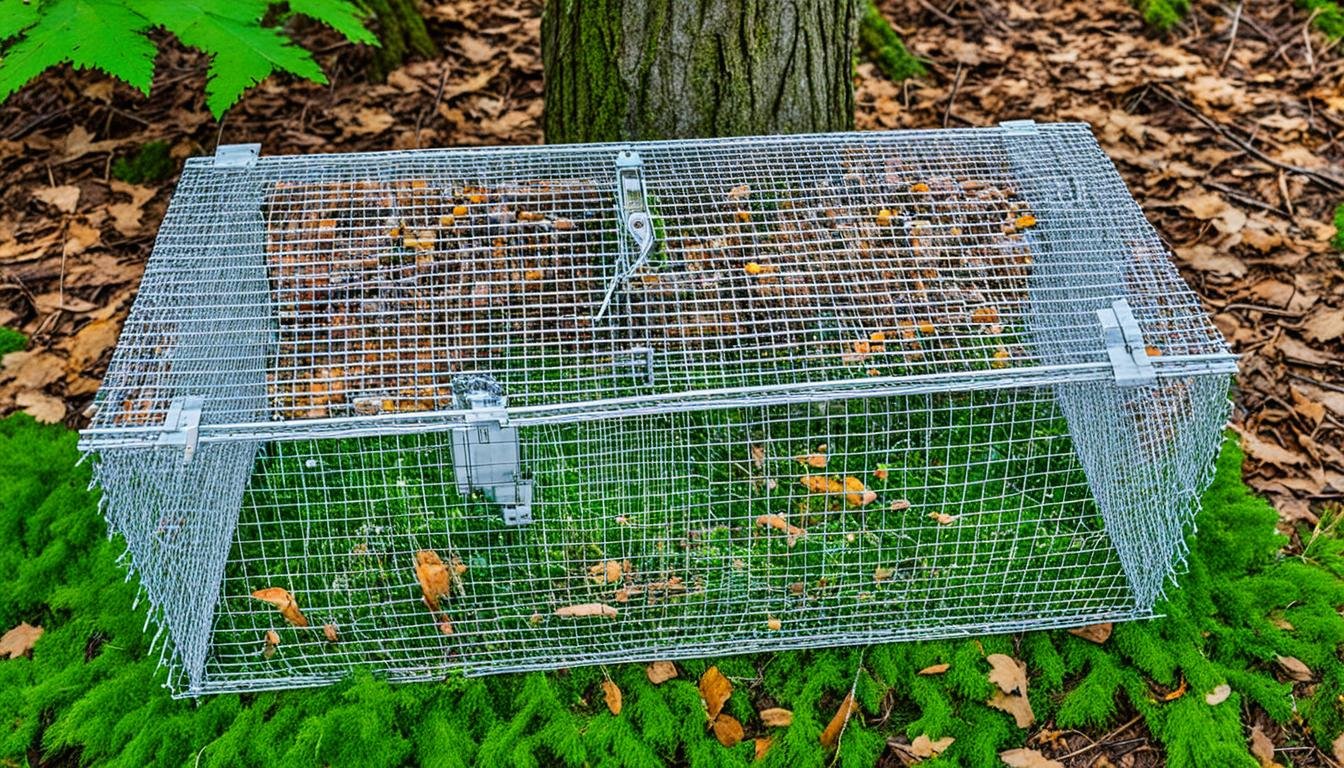Trapping squirrels calls for understanding both effective squirrel trapping techniques and the animals’ behavior. Homeowners often wonder about the effectiveness of squirrel traps, the use of rat traps for squirrels, and the role of glue traps. To answer these, it’s vital to discuss safe trapping methods that are kind to the animal and protect your property.
The Havahart® Easy Set® Trap is becoming a favorite for its humane, easy-use design. Its 2-door model provides more chances for both squirrel entry and successful capture. This trap stands out by appealing to tricky red squirrels with bait like nuts and seeds, though it’s great for gray squirrels too.
For the best results, check these traps twice every day. When dealing with many gray squirrels, try pre-baiting the traps. This gets them used to the trap, making future catches easier. Remember, squirrels can damage property and pose health risks through disease and parasites.
Making traps blend with their setting encourages squirrels to come closer without feeling threatened. This tactic, together with checking traps regularly, makes trapping both effective and kind. Employ these gentle strategies to solve your squirrel problems. You’ll then enjoy the peace of a squirrel-free home.
Understanding Squirrel Behavior for Effective Trapping
To catch more squirrels, it’s important to really know how they live and act. Knowing about squirrel habits helps trappers pick the best strategies. Tree squirrels affect their surroundings a lot. They do many things that show how well they can adapt.
- Tree squirrels don’t give up easily. For instance, hunters in Nebraska caught over 17,500 of them in 2006. This shows they’re in large numbers and could become too many.
- They can also harm public utilities. In Omaha, they cause about $500,000 in damage each year to power facilities.
- Some squirrels, like flying squirrels in Nebraska, are protected and not often involved in conflicts with people. Knowing this is important.
- Even though many people like them, tree squirrels are seen as a problem by Wildlife Control Operators in the United States. This points to a need for good control methods.
- Their skill in getting into houses through small spaces highlights the need for keeping buildings in good repair to stop them from entering.
Knowing these squirrel behaviors helps trappers guess where squirrels will go. This makes it easier to catch them.
| Species | Average Size | Habitat | Reproductive Age | Dietary Habits |
|---|---|---|---|---|
| Gray Squirrel | 15–20 inches (with tail) | Urban/Suburban with mature trees | 10–14 months | Oak acorns, hickory nuts, walnuts, etc. |
| Red Squirrel | 10.5–15 inches (with tail) | Mature coniferous forests | 10–12 months | Conifer seeds, fungi, buds, etc. |
Learning about squirrel habits shows why traps must be where squirrels naturally go. Use this knowledge to pick the best baits and places for traps. This will help you catch more squirrels.
Also, knowing if squirrels are active at dawn, dusk, or during the day tells you when to check traps. Your plan should follow their routine. This makes trapping both kind and effective.
The Legalities of Squirrel Trapping: What You Need to Know
Squirrel trapping isn’t just about setting a trap. It follows strict laws to protect wildlife and keep nature balanced. Before you start, it’s key to learn about the rules in your state and follow them. This keeps you ethical and out of legal trouble.
Familiarizing Yourself with State Regulations
State laws on trapping vary greatly. They impact how you trap squirrels and other small animals. While 12 species can be trapped without permits in some scenarios, other situations require specific permits. Knowing the rules for different animals and places is vital for legal trapping.
Ensuring Humane Treatment of Wildlife
Laws make sure animals are treated humanely once caught. They must be released or euthanized within 24 hours, depending on local rules. It’s illegal to keep, sell, or give away trapped animals after 24 hours. These laws show we must treat wildlife with respect.
This shows the importance of respecting nature when trapping. Commercial trappers must check their traps daily and follow strict rules. This ensures animals are treated well.
The laws are strict to protect wildlife and people from harm. In places like Massachusetts, moving wildlife is banned, and breaking the law can lead to fines or jail. This warns against illegal trapping.
Knowing the laws and humane practices in trapping is essential. It protects the animals and keeps you legal. You can find forms and information online to help follow these rules.
Best Strategies for Identifying Squirrel Activity
Dealing with squirrels involves figuring out where and how they’re active. These critters can affect both city and countryside locations. Observing squirrel signs is crucial for homeowners and nature watchers.
Recognizing Signs of Squirrels in the Attic
Think you have squirrels upstairs? The attic is their favorite spot. You can tell by the noise they make, like scampering or scratching, mostly during daylight. Also, chewed items or nests in your attic are giveaways. Moreover, finding droppings and a weird smell can mean squirrels are living above you.
Detecting Garden and Feeder Intrusions
Squirrels love messing with gardens and bird feeders. Look for signs like disturbed soil, damaged plants, or chewed up bird feeders. They do this to get to the seeds. Watching for these clues can help stop them from ruining outdoor areas.
Knowing all about squirrels can make a big difference. Below, a table breaks down their habits and where they like to hang out. This info is key for homeowners and trappers in managing squirrel problems effectively.
| Squirrel Species | Preferred Habitats | Activity Patterns | Feeding Hotspots | Seasonal Behavior |
|---|---|---|---|---|
| Eastern Gray Tree Squirrel | Residential areas, especially attics in winter | Active during early day hours | Oak trees, feeding on acorns | Stockpiling food in early to mid-fall |
| Fox Squirrel | Slightly more open woodlands | Activity peaks during warmer winter hours | Feeding on hickory nuts, black walnuts | Less active during coldest months, nest focused |
Choosing the right way to detect squirrel activity is key to stop squirrel damage. By watching for signs and understanding their behavior, you can protect your home from these nimble animals.
Safe and Humane Trap Selection
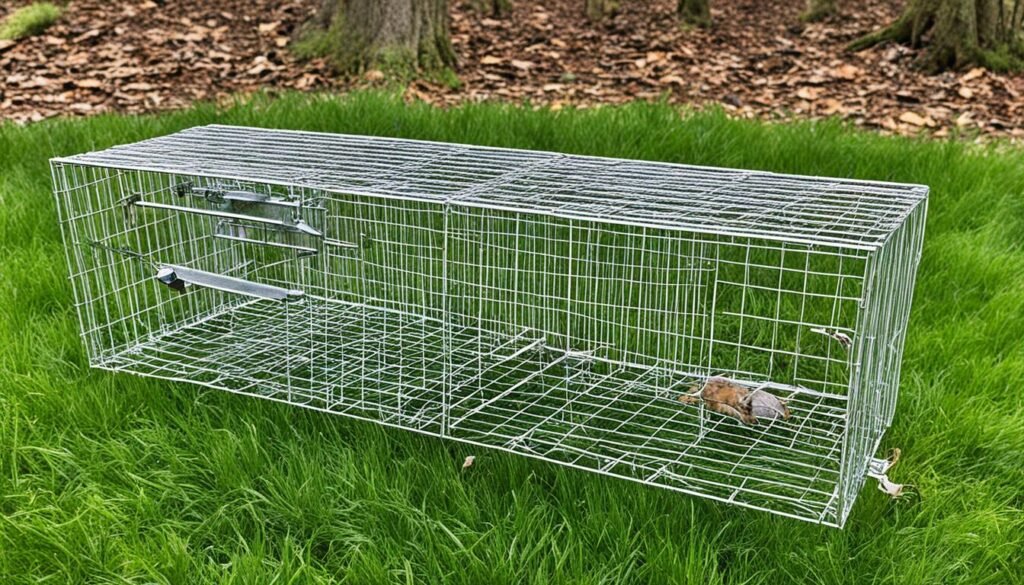
When dealing with wildlife conflicts, it’s important to choose a humane trap. This ensures both animals and humans stay safe. Since wild animals have a specific season for denning and nesting, the right safe trapping methods matter. It’s not just about removing the animal but doing so kindly. Take squirrels as an example. They might be troublesome, but need careful handling to solve human-wildlife clashes.
- Live cage traps are seen as very safe and come in sizes for all animals, from small rodents to big ones.
- For common home pests like opossums and raccoons, medium wire cage traps are used. But for tiny ones like mice and chipmunks, traps like the Sherman are better.
- It’s key to block where the animal got in after moving it. This stops others from coming in.
- Think carefully before relocating animals. Choose the right place and time to not harm them or nature.
For a gentle approach, here’s a quick look at humane trap types and uses:
| Type of Trap | Size Range (inches) | Target Animal | Usage Considerations |
|---|---|---|---|
| Wire Cage Traps | 16 x 5 x 5.5 to 72 x 20 x 26 | Small rodents to large dogs | Common for wildlife issues at home |
| Sherman Traps | 2 x 2.5 x 6.5 to 3 x 3.75 x 12 | Mice, Voles, Squirrels | Great for small mammals |
| Steel Leg-Hold Traps | N/A (Requires Permit) | Coyotes, Bobcats | Must be checked every 24 hours; need a permit |
| Snap Traps | Variable | Mice, Rats | Has adjustable sensitivity; works fast |
| Choker Loop Traps | N/A | Moles | Put in partly collapsed tunnels |
| Pincher Traps | N/A | Pocket Gophers | Also called Macabee or cinch traps; very effective |
Repellents, while useful, only work for a short time. If a den’s entry or exit is unused for a few days, it likely means the animals have left. Then you can seal it to stop others from entering. For homeowners, knowing about live cage traps and other techniques is key to making wise choices.
Good wildlife management depends on the method, timing, and respecting laws and animal rights. For example, using steel leg-hold traps requires permits and daily checks. But, traps for moles and gophers need careful placing to work.
Choosing the right trap means being effective and ethical. It’s about treating each animal with kindness, addressing the problem compassionately. The aim of humane trapping is not just catching but also safely releasing or relocating the animal. Cage traps are often the top choice for those looking to solve conflicts without harm. Whether facing a squirrel in the attic or a creature in the garden, picking the correct trap is crucial.
Trapping Squirrels: Placement and Setting Techniques
For successful squirrel trapping, placing traps correctly is key. You need to know where squirrels hang out, like near food or their homes in tree cavities. Keeping traps stable and secure is also crucial. This stops smart squirrels from getting away and makes sure the traps work right.
Optimizing Trap Location for Higher Catch Rates
Before you trap, putting food in traps can attract squirrels. Do this for a couple of weeks to see better results. Check your traps in the morning and evening to catch more squirrels and be kind. In places like Massachusetts, set traps by trees where you see many squirrels during their busy times at dawn and dusk.
Essential Tips for Securing and Stabilizing Traps
It’s important to secure traps well so they work as expected. If you can’t check a trap for over 12 hours, disable it to prevent hurting animals by mistake. Sometimes, you might need to move traps if you don’t catch any squirrels in two weeks. Properly securing traps also means they can handle weather and stop squirrels from knocking them over.
When planning your trapping, think about where and when squirrels look for food. For example, gray squirrels go for hickory nuts in fall and acorns in winter. So, setting traps near these foods can help. Also, during the hunting season in Massachusetts, which goes till the end of February, hunters choose specific rifles and shotguns for accuracy and ease of use.
Below is a table summarizing the ideal practices for trap placement and securing traps:
| Consideration | Recommendation for Trap Placement | Recommendation for Securing Traps |
|---|---|---|
| Pre-baiting Duration | 1-2 weeks | Stable and protected from tipping |
| Monitoring Frequency | Twice daily | Check and disarm if left unchecked over 12 hours |
| Location | Near tree cavities or known food sources | Relocate if ineffective after two weeks |
| Hunting Season | Based on squirrel activity and seasons | Use stable platforms to avoid accidental misfires |
Use these tips for trapping squirrels more effectively. Remember to follow wildlife laws to trap ethically and responsibly.
Live Trapping: The Compassionate Choice
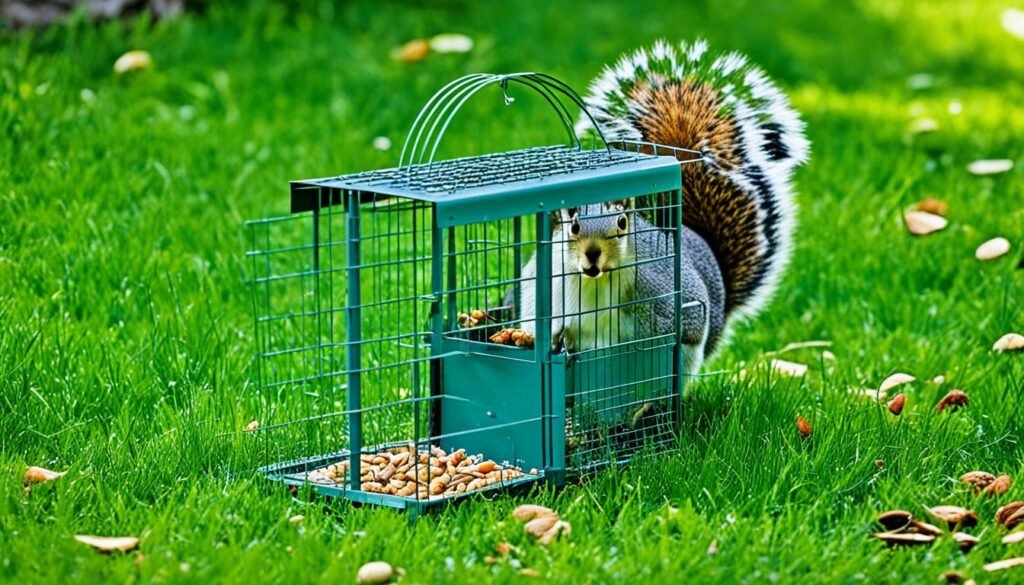
Urban development, especially in crowded places like the District of Columbia, has taken away a lot of wildlife’s homes. When animals like squirrels move into human areas, we need to remove them. But, traditional ways of doing this often don’t treat the animals well. People now know the problems with moving wildlife, like high death rates and lost babies. So, they’re choosing kinder methods like live trapping and one-way exclusion doors for humane squirrel removal.
Benefits of Using Single Animal Live Cage Traps
Choosing single animal live cage traps shows kindness towards animals. It’s important to pick the right trap, so the squirrels are caught safely and treated well. These traps have several benefits:
- They keep the trapped animal safe and reduce injury risks.
- They let you check on the animal’s health often.
- They lower the chances of leaving baby squirrels behind, a usual problem.
- They help release squirrels into places they can survive better.
How to Use One-Way Exclusion Doors
In spring and summer, animals look for safe spots to raise their young. Using one-way exclusion doors as part of live trapping is getting popular. These doors let squirrels leave but not come back. This is great for catching moms away from their babies or during nesting times. Here’s how to use these doors:
- Find where the squirrel gets in.
- Put the door there so it lets them leave but not come back.
- Watch the area to make sure all squirrels have left.
- Then, close off the entry for good.
By using live trapping and one-way exclusion doors, we can manage wildlife kindly and effectively. Experts can help a lot, following the rules and taking good care of the animals, while keeping away the bad outcomes of old methods. As cities grow, it’s our job to use these humane squirrel removal methods. That way, we can live peacefully with the wildlife around us.
| Method | Benefits | Considerations |
|---|---|---|
| Single Animal Live Cage Traps | Safety for animals, checks on well-being, better survival rates | Requires correct placement and habitat selection for release |
| One-Way Exclusion Doors | Prevents re-entry, allows squirrel families to exit safely | Must ensure all animals have vacated before sealing entry |
Optimal Baiting Tactics to Lure Squirrels
Getting squirrel baiting tactics right is key to trapping them. Choosing effective bait for squirrels and where to place it matters a lot. Knowing what squirrels like to eat will help you catch them better.
Nuts and peanut butter are top picks for luring squirrels. When nuts are in their shells and mixed with peanut butter, they work well in trapping. Grains and seeds are good too, as they remind squirrels of their usual food, like from a bird feeder.
- Nuts and peanut butter attract squirrels well.
- Peanuts in their shells, with peanut butter, work better.
- Grains and seeds are also effective for trapping.
For squirrels that love something sweet, try citrus or apple slices. These baits are great for catching several squirrels at once. Bread with peanut butter or marshmallow is another great choice for your traps.
- Fruit like citrus and apples work well for catching squirrels.
- Bread with peanut butter or marshmallow also lures them in.
While doing it yourself can save money, hiring professionals might cost $200 to $600. But remember, it’s important to treat squirrels kindly. The Humane Society suggests not releasing squirrels in winter to avoid starvation. They say to relocate them at night, at least five miles away.
Aside from baits, using deterrents can help with trapping. Try scents like peppermint, rosemary, garlic, or cinnamon near your traps. Capsaicin, which makes chili peppers hot, can also keep squirrels away from places you don’t want them.
- Adding deterrents to your plan is a smart move.
- Using natural scents can guide squirrels to traps.
- Spicy capsaicin repellents deter squirrels effectively.
With these tactics and knowledge of squirrel habits, you can trap them more humanely and successfully.
Relocating Squirrels: Best Practices and Considerations
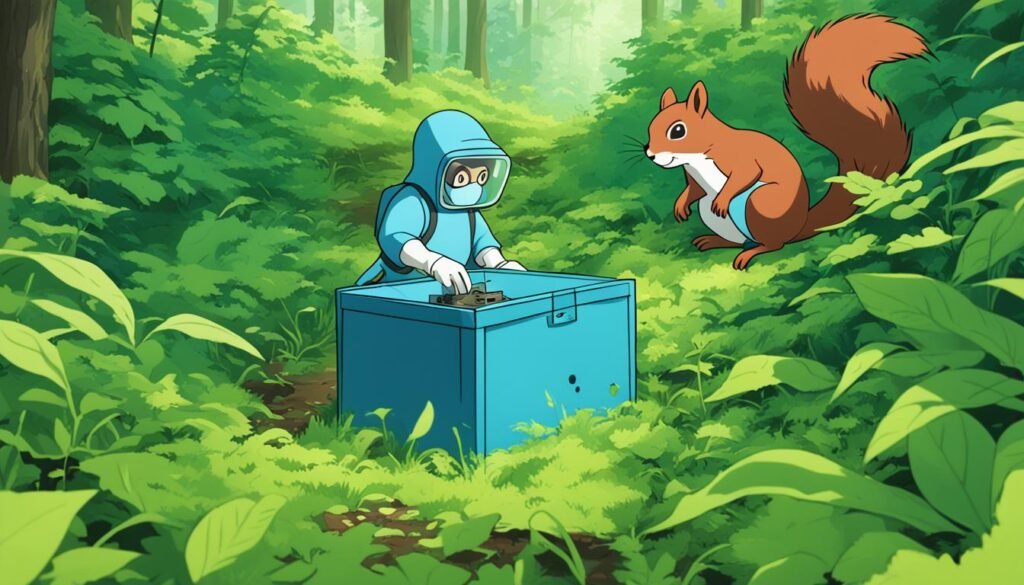
Relocating squirrels is key to managing wildlife and preventing damage. It shows we care about the environment. It’s not just about moving them safely. It’s also about keeping nature in balance. Let’s look at how we can take care of them during this process.
Procedures for Safe Handling and Transport
When handling squirrels, we should wear gloves and be gentle. They need a secure, comfy box with good air. This box must also protect them from too much sun or cold. Remember, these creatures can feel stress. We have to be mindful of their comfort.
Balancing Squirrel Welfare with Environmental Responsibility
We must relocate squirrels responsibly. Their new home should have enough food and not too many squirrels already. This stops overcrowding and fights, making sure all squirrels stay happy and healthy.
Squirrels can cause big problems, like power outages, which cost a lot to fix. In Lincoln, Nebraska, they led to expensive repairs. Putting up squirrel guards has helped lower these costs a lot.
| Year | Location | Outages Caused by Squirrels | Estimated Annual Costs (2010 Prices) |
|---|---|---|---|
| 1980 | Lincoln, NE | 177 (24% of all outages) | $61,005 |
| 1985 | Omaha, NE | 332 | $94,237 |
| 1985 (After Guards) | Lincoln, NE | Significantly Reduced | $10,290 |
Squirrel relocation is complex. We should think about their long-term health and stress. Biologists measure stress through FCM levels. Studies show that while relocated squirrels move a lot at first, they adjust after two weeks. This shows they can get used to new places.
For squirrel relocation to work, we need careful planning and kindness. We must follow the law and treat the squirrels well. Doing this helps nature, our buildings, and the squirrels. It’s all about taking good care of our world.
Maintenance and Monitoring of Traps for Continuous Control
For continuous squirrel control, setting traps is just the start. It’s important to keep traps well-maintained and checked regularly. Doing this ensures traps work well for a long time, in cities and the wild. Knowing how to maintain traps and prevent trap shyness in animals is key to wildlife management.
Regular Inspection to Ensure Trap Integrity
Checking traps often is critical for their success and longevity. Fixing any issues quickly makes trapping more effective and kinder to animals. New technologies, like smart traps, make monitoring easier, needing less human effort and saving resources.
Addressing and Preventing Trap Shyness in Squirrels
To manage wildlife in the long run, avoiding trap shyness is crucial. This happens when animals start avoiding traps they’ve seen before. By moving traps and using different baits often, we can stop this. Looking at how traps work in various areas can also help improve our methods and keep animals from becoming trap shy.
| Trapping Element | Purpose | Considerations |
|---|---|---|
| Automated Monitoring | To minimize human intervention and consistent physical checking of traps. | Battery life, signal range, weather resistance. |
| Trap-nights Aggregation | A metric for evaluating trapping efforts and guiding evidence-based management, per ISO standards. | Difficulty in isolating the impact of trap number from duration. |
| Injury Reduction | To ensure traps meet humane standards and minimize wildlife injuries. | Compliance with ISO 10990-4 and ISO 10990-5 standards on trap testing. |
| Evaluation of Trapping Data | To accurately estimate animal populations and assess the effectiveness of trapping operations, as demonstrated by the RSU project. | Accounting for biases such as detectability, observer bias, and data availability. |
| Trap Shyness Prevention | To maintain the efficacy of traps over time by avoiding the conditioning of animals to avoidance behaviors. | Trap variation, relocation, and camouflage strategies are key. |
Preventative Techniques to Keep Squirrels at Bay
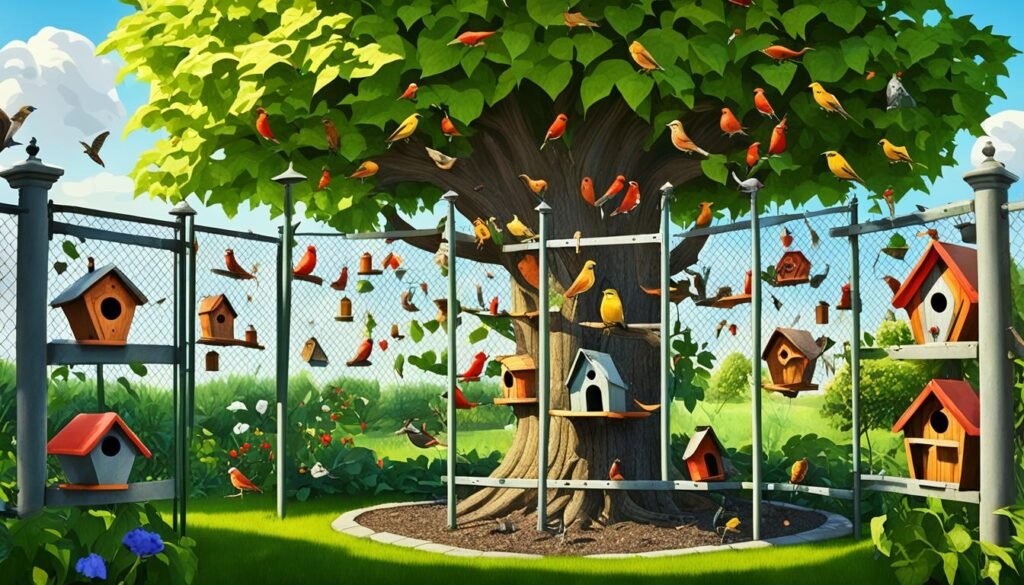
Stopping squirrels involves using different methods to protect properties. By taking smart steps, owners can reduce squirrel problems and keep areas trouble-free.
One way is to spray apple cider vinegar, which helps keep squirrels away. But, you need to spray often to keep it working well. Using motion sensor sprinklers is another good idea. They scare squirrels off but use more water.
Ultrasonic devices can also cut down on squirrel visits. Make sure the device covers the whole area you want to protect. Catching and moving squirrels gently is another method. It’s key to watch how quickly squirrels are caught and moved kindly.
Safflower seeds in bird feeders can help too, as squirrels don’t like them much. This also stops feeder damage. Using fox urine in gardens can also stop squirrels from coming in.
There are many products for sale, like repellent concentrates and traps. Homeowners can find effective tools for fighting squirrel problems.
Natural options like Irish Spring soap and vinegar work well and save money. Keep squirrels away by sealing up holes, using mesh, cutting tree branches, and cleaning up food outside. Pets at home can help scare them off too.
Using these methods together can really help keep squirrels away. It shields properties from their constant problems.
Professional Squirrel Removal Services Versus DIY Approaches
Homeowners often have to choose between professional squirrel removal or DIY methods. This decision affects both immediate and long-lasting control of these critters.
DIY methods attract those looking for an affordable and hands-on solution. It’s rewarding for those who enjoy wildlife challenges. But, it demands a lot of time, understanding of squirrel behavior, correct trapping methods, and careful steps to be humane.
Choosing professionals, however, means getting help from experts. They manage everything from finding how squirrels get in to making sure all are removed. Clients get the advantage of professional tools and methods for a better, longer-lasting solution.
-
Benefits of Professional Squirrel Removal
-
Expertise in Humane Trapping Methods
-
Assessment of Property to Prevent Future Infestations
-
Reliable Resources and Specialized Equipment
-
-
Limitations of DIY Squirrel Trapping
-
Requires Extensive Knowledge and Time Investment
-
Risk of Injury or Inhumane Treatment
-
Potential Damage to Property from Improper Techniques
-
When looking at your options, think about the infestation’s size. DIY might work for small issues. But, big or ongoing problems often need pros. We’ll look closer to help decide.
| Aspect | DIY Squirrel Trapping | Professional Removal |
|---|---|---|
| Initial Cost | Lower upfront investment in traps and baits | Higher due to service fees but can lead to cost savings long-term |
| Expertise | Dependent on homeowner’s knowledge | Handled by trained experts in wildlife control |
| Safety | Potential risks to untrained individuals | Safety ensured by professionals |
| Time Commitment | Significant amount of personal time required | Minimal time required from the homeowner |
| Long-Term Effectiveness | Varies based on execution | Comprehensive and sustainable solutions |
| Stress on Wildlife | Potential for unintentional harm | Less stress with humane and ethical practices |
Choosing DIY or professional help, remember to always use humane methods. Follow local wildlife laws to be responsible and lawful in your actions.
If you have ongoing or complex squirrel issues, professional help is crucial. They assess the problem, apply the best strategies, and offer service guarantees. This gives you comfort and keeps the squirrels safe.
Conclusion
We have looked at different ways to trap squirrels safely and successfully. The study from 1952 to 1959 in Louisiana tracked 1478 squirrels. It showed setting traps before hunting season can control their numbers and lessen impact. A special note goes to Thistlethwaite in 1959 for catching more gray than fox squirrels.
In 1961, setting 194 traps near Thistlethwaite’s roads led to a lot of catches. But, it also showed dangers to squirrels from predators and the weather. It was interesting to see how hunters thought there were more squirrels because of the traps they saw.
To sum up, good trapping means looking out for the animals and the whole ecosystem. Our work with squirrels is about being kind and taking care of our environment. The stories and facts we’ve shared show how to manage well but also remind us to respect all living things around us.
FAQ
What are some efficient methods for safely trapping squirrels?
You can catch squirrels safely using live cage traps or one-way doors. Make sure the method you choose is kind to the squirrels.
How can understanding squirrel behavior enhance trapping success?
Knowing how squirrels behave helps you pick the best trap and bait. It also helps you know where to put the trap to catch more squirrels.
What legal regulations should I be aware of when trapping squirrels?
You need to know your state’s trapping laws to stay legal. Always treat the wildlife you catch with care.
How can I identify squirrel activity in different areas?
Look for signs like chewed wires, droppings, and damaged plants. These clues show where squirrels are active and help you trap them.
What should I consider when selecting a trap for squirrel trapping?
Pick a trap that’s safe for squirrels, like a live cage trap. Make sure the squirrel can be released or moved safely.
What are some placement techniques for effective squirrel trapping?
Put your trap in areas where squirrels are very active. This could be near attics or where they eat. Make sure the trap stays in place so squirrels can’t escape.
Why is live trapping a compassionate choice for squirrel removal?
Live trapping lets you catch and move squirrels without hurting them. Using the right traps and doors is key to doing this kindly.
What are some effective baiting tactics for squirrel trapping?
Use nuts, seeds, or peanut butter as bait. These foods attract squirrels and make your trap more successful.
How should I handle and transport captured squirrels for relocation?
Be gentle and keep the squirrels calm when moving them. Wear gloves and think carefully about where to release them.
How should I maintain and monitor traps for continuous squirrel control?
Check your traps often for any damage or problems. Fix any issues to keep trapping squirrels effectively.
What are some preventative techniques to discourage squirrels from entering properties?
Block their entry points, use mesh barriers, and try repellents. These methods help keep squirrels away from your property.
What are the advantages of professional squirrel removal services compared to DIY approaches?
Experts have the skills and tools for tough squirrel problems. DIY can work for simpler issues.
What are the key takeaways for trapping squirrels safely and effectively?
Use gentle traps and know squirrel behavior for best results. Stick to the law, pick the right trap and bait. Also, keep your traps in good shape and use deterrents to keep squirrels away.

